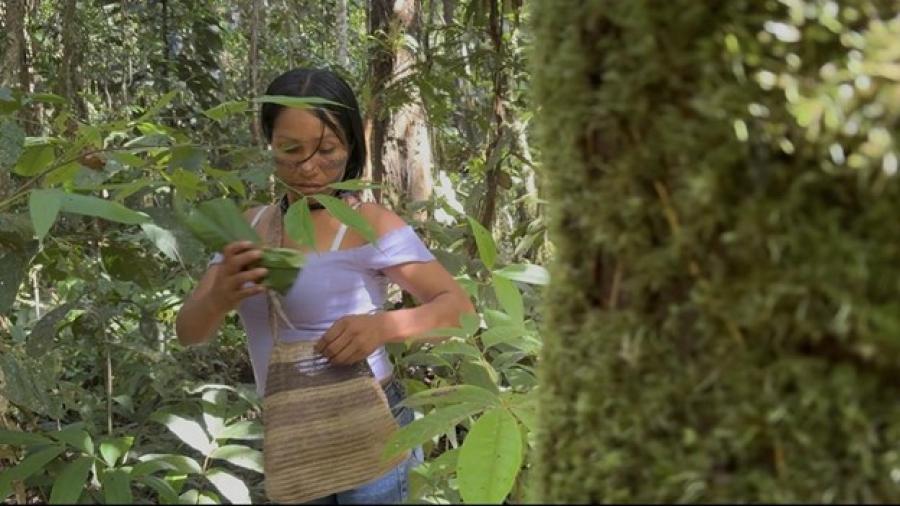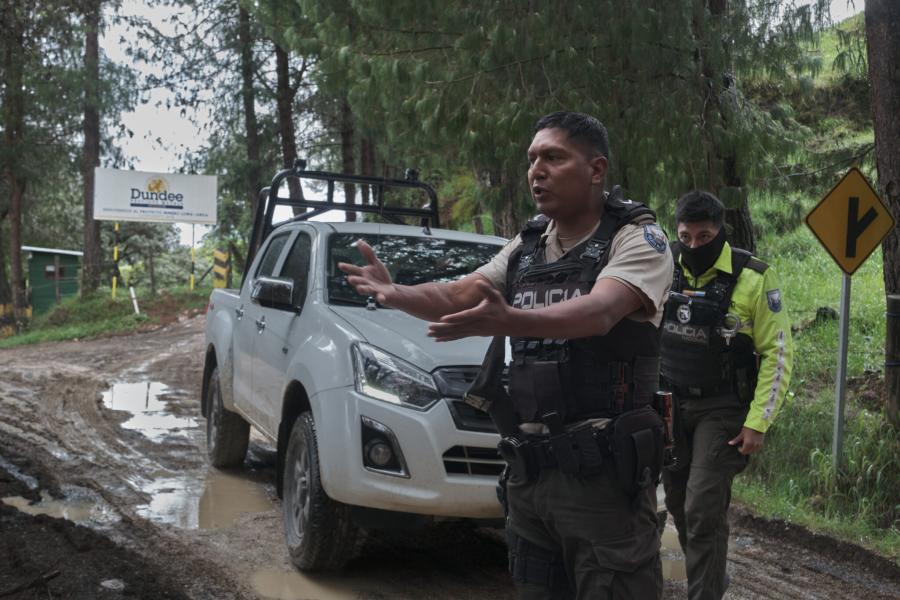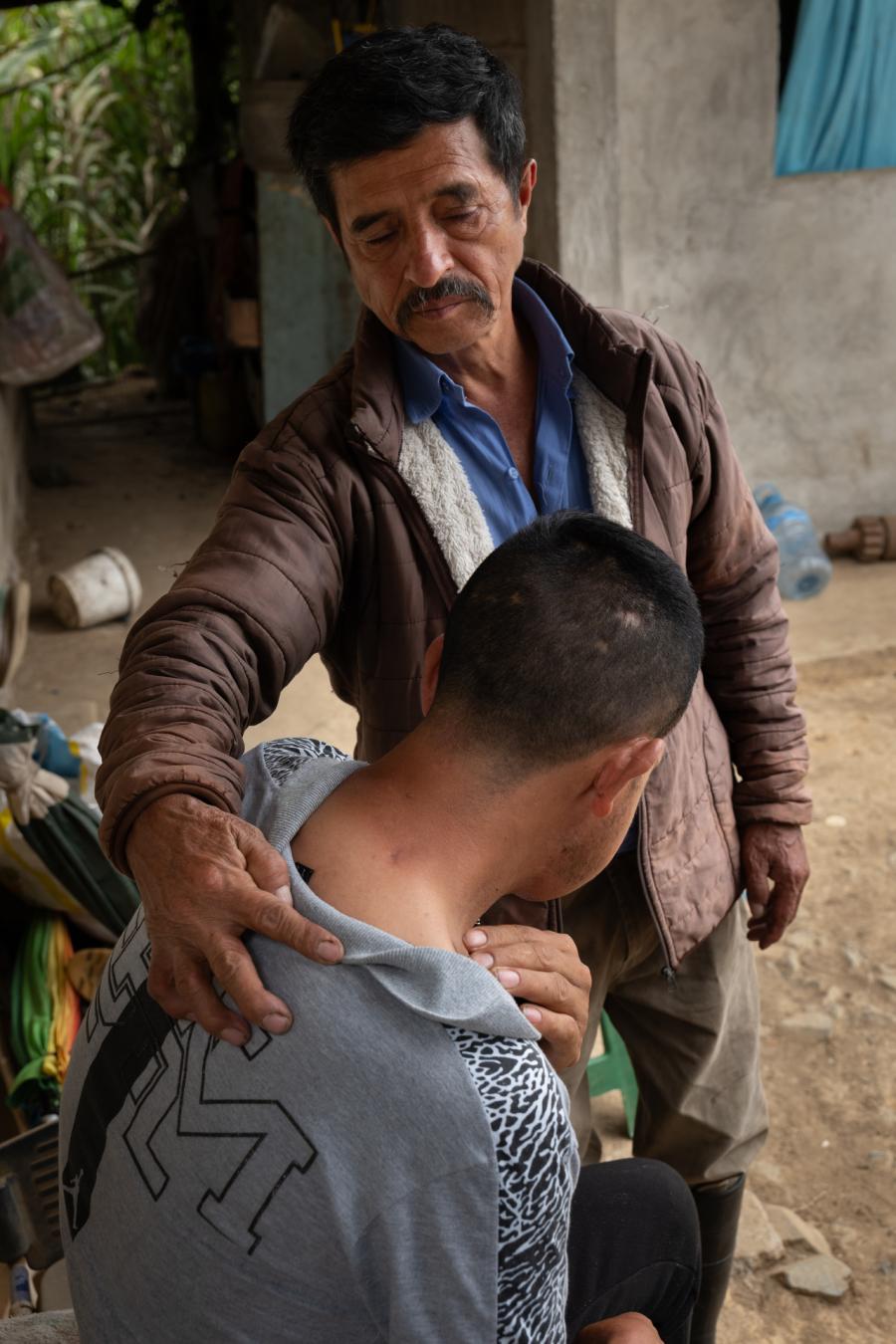While the morning mist still hovers above the streams and rivers of the jungle east of Ecuador's Sierra de Cutucu, Shuar Indian adults head off to tend their gardens and pastures. Meanwhile, their children walk to a small building in the center of a recently nucleated settlement. It's new school, the settlements first in fact. Their parents built it.
Many schools in Latin America are constructed in a similarly communal way. What's unique about Shuar schools is what's inside; instead of a non-Indian teacher assigned by the Ministry of Education, a member of the community stands before the students, a small portable radio beside him. He is a teacher's aide, teleauxilar, who, from 7:30 a.m. until 1 p.m., monitors and interprets the lessons of teachers, telemaestros, who broadcast to hundreds of such schools from the headquarters of the Shuar Federation in the town of Sucua, over the distant ridge of the Cordillera. The radio school provides basic and secondary education (math, reading, writing and history) - mainly in the Shuar language - as well as traditional music and folk tales. After school the children are free to assist their parents, and in the process acquire essential agricultural skills.
Why was the Shuar educational system set up this way(7) First, and perhaps least important, despite mandatory primary education it was nearly impossible to find a non-Indian teacher willing to work in the isolated, alien settlements of the interior jungle, let alone one who could do so in Shuar, the only language spoken by the students.
Before the Bilingual-Bicultural Radio school was established there were no schools. To obtain any education Shuar children had to attend boarding schools established by Salesian missionaries in one of about 13 urban mission stations, usually at least three to five days' walk from home. While they learned to read and write for years in these enclosed quarters, they lost the chance to pick up the sort of Shuar history and culture that is transmitted orally and irregularly by elders as the families cluster around the hearth in the early morning and late evening. Nor could the children practice gardening, hunting, fishing or any of the other essential aspects of life in the tropical forest. Likewise, students were encouraged by the missionaries to marry their classmates, rather than obtain a mate through traditional patterns of kinship and marriage. So, to become "educated," children could easily miss the opportunity to become a Shuar. For the proud Shuar, and several of the more broadminded Salesian missionaries who worked among them, this was unacceptable. Therefore, cultural continuity was the second, but principal, reason for establishing the bilingual-bicultural schools.
The sophisticated Shuar Bilingual-Bicultural Radio School program is a reflection of the equally sophisticated Shuar Federation which, with the approval of the Ministry of Educational, runs the schools. The Shuar Federation is, by its own account, a unique solution to a present-day problem. In the early 1960s the Shuar faced an unprecedent crisis; their territory, previously unviolated due to the Shuar's fierce reputation (heightened by the imagery of the shrunken heads of their enemies suspended from the roof beams), was being invaded successfully by colonists from the adjacent Andean highlands. The Shuar's loose political organization and dispersed settlement pattern offered little defense. So, aided by some of the Salesian missionaries, several Shuar families in the area around Sucua joined to form a centro. Others followed the example and later established larger administrative units called asociaciónes. In January 1964 they combined to create the Federation of Shuar Centers, commonly referred to as the Shuar Federation. Since then the federation has expanded to include over 30,000 members and has achieved a high degree of respect both within Ecuador and internationally for the degree of self-determination obtain.
Initially, to establish an acceptable land use program for the defense of their lands, the Shuar obtained substantial funds for a cattle program that provides credit and technical assistance to the centros but is administered by the federation. The management skills essential to run the cattle program required the aid of their educated elite, and thus drew many back into the ethnic fold. It is so well managed that it has been lauded by institutions such as the World Bank. Equally important, this experience set up the administrative structure essential for programs such as the radio school, which, after the cattle program, is the most ambitious effort undertaken by the Federation.
Inaugurated in 1972 with the approval and over-sight of the Ministry of Education, the radio school now broadcasts to nearly 4,000 elementary school students and about 1,000 secondary students. The daily programs are developed by a planning unit of about 10 Shuar with advanced degrees in education. The lessons they prepare are transmitted by two to four teachers, telemaestros, who work from enclosed broadcast rooms at the Shuar headquarters. During the school day the teleauxilaries, all with primary education and regular advanced training by the federation, stand beside the radios, either writing directed lessons on the board or taking over the entire classroom when there are pauses in the program. The schools, numbering over 150, range in size from four students clustered in a makeshift hut to a well-constructed building with 30 or 40 students. The primary and secondary program ends at 1 p.m., but there are adult literacy programs in the afternoon and cultural programs in the early morning and evening. In all, the radio functions about 12 hours each day.
The idea is imaginative; but now is it working Quite well. Before the radio schools were established, about 60 percent of the Shuar never attended school. Of those who did, at least 30 percent left before finishing primary school. Those who did become lingual program; several went off to universities in the capital, with scholarships from the Shuar Federation or the Salesian missionaries. Some received further training in Europe.
Unlike many educated elites, most of the Shuar returned to work with the federation. The radio school has been one of their most effective programs. Eighty percent of the Shuar now graduate from primary school (sixth grade), and as mandatory education now requires secondary school, the federation has responded by developing a program to provide training for the first three years of secondary school as well. Cultural Survival presently provides financial assistance to support the teachers' aides for this secondary education program. However, as the Ministry of Education gradually provides funds for these new slots in the national education program, Cultural Survival's aid will diminish. Increased government support for the program is complicated at present by the severe national economic situation, but is facilitated by the fact that the program provides required education to a large population at a per-student cost of about one-half that of other schools.
In addition, the radio courses in adult literacy have reduced illiteracy to about 10 percent, most of whom are elderly. At present there are no statistical evaluations that compare those who finish primary and secondary radio school with the national average. However, several factors indicate that Shuar students would fare as well as, if not better than, the national level. Among these indicators is the degree of consistency that exists in Shuar education; programs are prepared and evaluated by an experienced planning group before they are broadcast. Teleauxilaries are provided with regular training. In addition, schools are in session rain or shine, in a jungle environment where both student and non-Indian teacher absenteeism would otherwise be chronic.
More important is the Shuar's attitude toward their radio school program. Education is now a source of great pride, and the radio school has become its symbol. Although there is a federation-imposed penalty of four days in jail for failure to send one's child to school, the punishment rarely needs to be enforced. Moreover, only about one percent of the Shuar families choose to send their children to anything other than the radio schools. The federation has established a scholarship program for radio school graduates that has allowed many to attend high school and university. Finally, the program has indirectly strengthened the democratic and participatory nature of the federation as a whole. The structure is hierarchical but responsible to the communities. Those who prepare the programs received advice from the teleauxilaries who, as members of the community, are in regular contact with students and their parents, who are free to comment on the content and quality of the program. This would never have been the case if boarding schools had continued to provide the only education.
The Bilingual-Bicultural Radio Schools, and by extension the Shuar Federation, can only become stronger through such interaction. As such they not only provide a service to their members, but an example for any group concerned with self-determination, maintaining a strong sense of ethnic identity, and procuring the skills necessary to confront, as equals, other segments of a pluralistic society.
Article copyright Cultural Survival, Inc.



